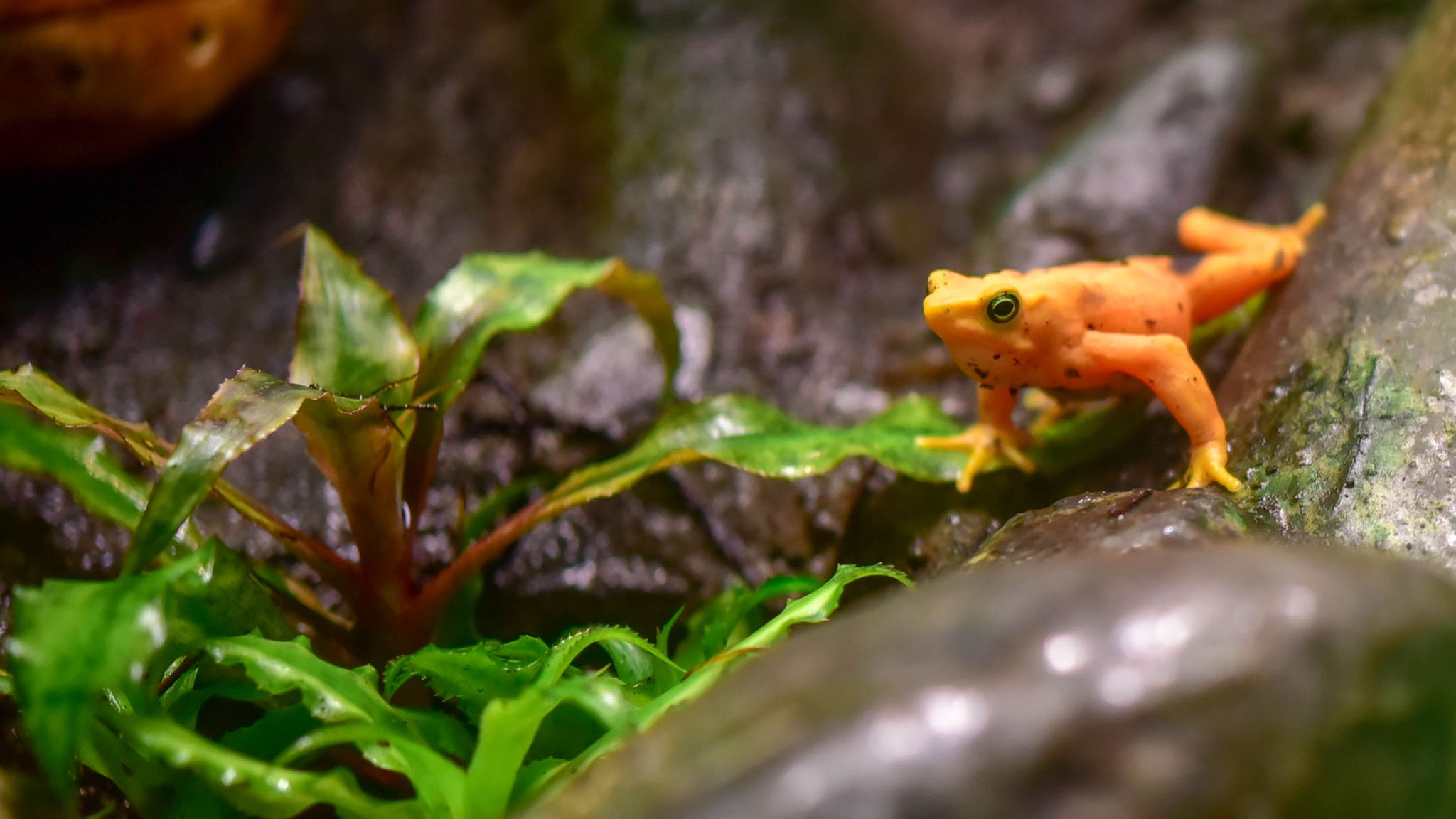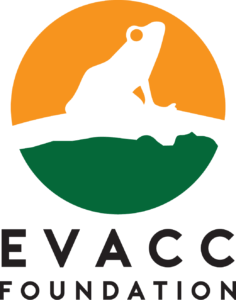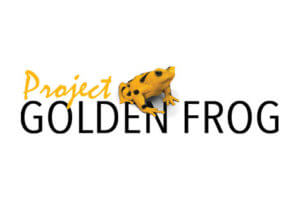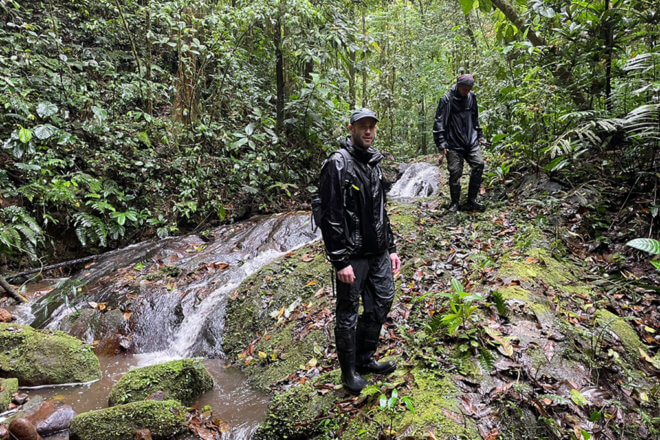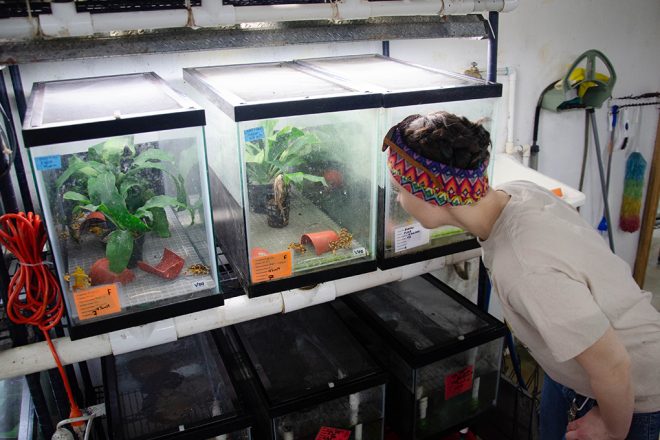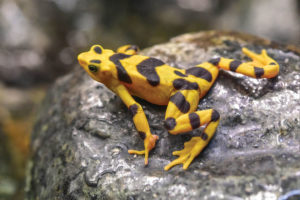
Working to Save a Critically Endangered Species
Visitors to the Zoo can see Panamanian golden frogs (PGFs) in the rainforest setting of the Chimpanzee Forest building. Yet this small display holds only a tiny percent of the PGFs cared for at the Maryland Zoo. The Panamanian Golden Frog Conservation Center within the Zoo’s hospital is home to hundreds of these black and gold frogs.
Amphibians of all kinds face multiple threats including habitat loss, pollution, disease, climate change, and collection for the pet trade. While encountering all of these challenges, PGFs have been particularly hard-hit by a fungal disease called chytridiomycosis, or chytrid for short. Chytrid does not harm humans or other mammals, though we can certainly spread the disease. Even some amphibians such as bullfrogs do not appear to suffer ill effects from chytrid, but they can be carriers. But in vulnerable amphibians like PGFs, chytrid disrupts the skin’s critical functions, ultimately leading to death in the infected individuals.
The microscopic fungus that causes chytrid, Batrachochytrium dendrobatidis, is not native to Panama. Like many non-native species brought to a new part of the world, the fungus was able to spread unchecked through Central and South America. In the late 1990s, biologists began to understand the devastating large-scale effects of chytrid on whole populations of amphibians. Since the early 2000s, a group of institutions including the Maryland Zoo (see Project Golden Frog below) has been working to sustain healthy populations of PGFs in zoo care until frogs can be released safely to their native habitat. Panamanian golden frogs have not been sighted in their native range since 2009. For a species that is potentially extinct in the wild, the Zoo’s continuing conservation efforts are crucial to the species’ survival.
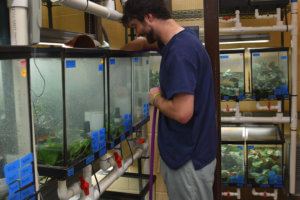
Propagating PGFs Ex Situ
The Maryland Zoo was the first institution to successfully breed Panamanian golden frogs ex situ, or, “outside the native habitat.” Today, the Maryland Zoo is home to the largest population of Panamanian golden frogs outside of Panama. The Zoo continues to lead other institutions in the successful breeding and management of this species.
Breeding any animal in a zoo environment can be a complex task. Male–female pairings for breeding are carefully planned to ensure that the population overall retains as much of the natural genetic diversity of the species as possible. Beyond genetics, in-depth understanding of species’ life-cycle characteristics, breeding behavior, nutritional needs, and general health of individuals are all keys to maintaining strong populations. The Zoo’s animal care and veterinary staff have developed expertise in these areas through their years of day-to-day work with PGFs and through careful studies to advance scientific understanding of this species.
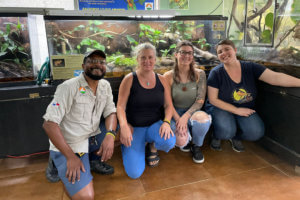
Partnering with Project Golden Frog and EVACC Foundation
Ex situ breeding of PGFs has allowed the species to persist while threats in their native range are addressed. Return of PGFs to their home range, however, has always been the goal. In 1998, a consortium of institutions in Panama and the United States formed Project Golden Frog/Proyecto Rana Dorada in anticipation of potential catastrophic effects of chytrid disease on amphibians in Panama. Their primary goal was to preserve the culturally significant PGF through ex situ conservation breeding, field studies, and educational programs.
In Panama, local conservationists are working to establish their own assurance colonies of critically endangered native amphibians, including PGFs. Project Golden Frog works closely with the El Valle Amphibian Conservation Center, or EVACC Foundation. This facility functions as both a breeding center for amphibians and as a discovery center for local visitors and tourists. With decades of experience in caring for and breeding PGFs, Maryland Zoo staff regularly travel to EVACC to offer support to these partners, including setting up amphibian breeding tanks, building exhibits for the discovery center, assisting with field surveys, and helping develop long-term plans for reintroducing frogs to the native habitat.
Visit the website for Project Golden Frog
How You Can Help Frogs and Other Amphibians
Leave wild amphibians where you find them.
- Amphibians have very sensitive skin. Picking them up can harm them, particularly if you have chemicals such as lotions on your hands. By leaving wild animals where you find them, you can also help avoid transmitting diseases between these animals and your pets. If considering an amphibian or reptile as a pet, be sure the animal is not wild-caught or imported.
Sanitize shoes and clothes after traveling.
- When we move across state or national boundaries, hidden travelers might be along for the ride. Not only can people spread viral, bacterial, and fungal illnesses like chytrid from one place to another, but seeds and even insect eggs may be crossing borders on the bottoms of shoes or attached to clothing. In a new environment, these transplanted species may flourish, harming the local ecosystem. To decrease the risk of spreading potentially harmful organisms, thoroughly clean and sanitize shoes and other clothing before and after travel.
Do not release a pet amphibian or reptile into the environment.
- If the animal is not native to the habitat you release it to, the animal may feed on or outcompete local species, or it may transmit disease to local wildlife.
Avoid chemicals and pesticides.
- Due to their highly sensitive skin, amphibians can absorb chemicals from the environment. Pesticides also kill the insects that many amphibians depend on for food. Contact with some pesticides may be directly fatal to certain amphibian species. Other pesticides may lead to malformation of amphibian limbs or reproductive organs.
